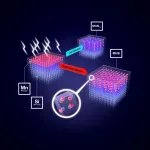(Press-News.org) Skyrmions - tiny magnetic vortices - are considered promising candidates for tomorrow's information memory devices which may be able to achieve enormous data storage and processing capacities. A research team led by the Helmholtz-Zentrum Dresden-Rossendorf (HZDR) has developed a method to grow a particular magnetic thin-film material that hosts these magnetic vortices. A central aspect of this new method is the abrupt heating of the material with short, very bright flashes of light, as the international team, consisting of scientists from HZDR, the Leibniz Institute for Solid State and Materials Research Dresden, TU Dresden (TUD), and Chinese partners, describes in the journal Advanced Functional Materials (DOI: 10.1002/adfm.202009723).
In 2009, a research team had made a remarkable discovery: They found that tiny magnetic vortices can form in a material called manganese silicide - an alloy of manganese and silicon. Since then, these skyrmions, named after British physicist Tony Skyrme, have been considered promising candidates for future magnetic storage devices. They can be easily formed on and erased from surfaces and are no larger than a few nanometers (billionths of a meter), which makes them much smaller than the magnetic bits on today's hard drives that measure about 50 nanometers.
"In addition, skyrmions can be better targeted with electricity than with magnetic fields, as is done with current hard drives," explains Dr. Shengqiang Zhou, a physicist at HZDR's Institute of Ion Beam Physics and Materials Research. "Targeting with an electric current allows us to achieve better scalability, which might enable us to build much denser and faster storage devices in the future." But there are still some obstacles to overcome along the way. Among other things, silicon and manganese present an unfavorable property when they form crystals of manganese silicide: Instead of consistently producing one specific, well-defined phase, the two elements can form many different crystal phases. Thin films of an Mn-Si alloy, known as the B20 phase, are particularly suitable for the formation of skyrmions.
Undesirable crystal phases
Producing this alloy is anything but easy, though, because another undesirable crystal phase, called MnSi1.7, inevitably forms during the production process, impeding or preventing the formation of skyrmions. Specifically, lower temperatures and slower cooling of the material favors MnSi1.7. Shengqiang Zhou's team has now developed a method that prevents its formation, leaving only thin layers of flawless B20-MnSi.
The core element of the new process is a special heat treatment. "It's a bit like making a pancake," Zhou explains. "It tastes best when it is crispy on the outside and as soft as possible on the inside." When you pour the batter into a hot pan, it bakes so fast that the inside stays nice and soft. When you bake the batter in the oven, however, it heats up much more evenly and hardens all over - and you get a rather mediocre pancake.
Heating with flashes
So the experts used this pancake strategy of rapid, intense heating as their model. "When we heat a thin manganese film placed on top of a silicon wafer very briefly, we introduce very little energy into the material," Zhou explains their rationale. "This means it will cool down fast - so fast, in fact, that the unwanted MnSi1.7 won't have time to form." The challenge is how to heat something rapidly and vigorously at the same time. The research group found the solution in bright, intense flashes of white light.
Such flashes can be generated at the "BlitzLab", a Helmholtz Innovation Lab located on the Rossendorf campus. Various series of measurements confirmed the assumption: "By varying the power of the flashes, we were able to adjust the ratio of the different crystal phases with great precision," reports Shengqiang Zhou. "When we applied relatively strong powers, thin films of pure B20-MnSi formed as we had hoped."
As a result, the skyrmions that can be generated in these layers are now stable over a much wider temperature and magnetic field range than previously observed in this material. Manganese silicide itself is unlikely to be suitable for practical use since it only works at very low temperatures. But it could serve as an important model for other, more practicable materials. "Many alloys pose the problem that they have different phases," Zhou explains. "And our approach could help separate these phases in the future."
INFORMATION:
Publication:
Z. Li, Y. Xie, Y. Yuan, Y. Ji, V. Begeza, L. Cao, R. Hübner, L. Rebohle, M. Helm, K. Nielsch, S. Prucnal, S. Zhou: Phase selection in Mn-Si alloys by fast solid-state reaction with enhanced skyrmion stability, in Advanced Functional Materials, 2021 (DOI: 10.1002/adfm.202009723)
For more information:
Dr. Shengqiang Zhou
Institute of Ion Beam Physics and Materials Research at HZDR
Phone: +49 351 260 2484 | Email: s.zhou@hzdr.de
Media contact:
Simon Schmitt | Head
Communications and Media Relations at HZDR
Phone: +49 351 260 3400 | Email: s.schmitt@hzdr.de
The Helmholtz-Zentrum Dresden-Rossendorf (HZDR) performs - as an independent German research center - research in the fields of energy, health, and matter. We focus on answering the following questions:
How can energy and resources be utilized in an efficient, safe, and sustainable way?
How can malignant tumors be more precisely visualized, characterized, and more effectively treated?
How do matter and materials behave under the influence of strong fields and in smallest dimensions?
To help answer these research questions, HZDR operates large-scale facilities, which are also used by visiting researchers: the Ion Beam Center, the High-Magnetic Field Laboratory Dresden, and the ELBE Center for High-Power Radiation Sources.
HZDR is a member of the Helmholtz Association and has six sites (Dresden, Freiberg, Grenoble, Leipzig, Schenefeld near Hamburg) with almost 1,200 members of staff, of whom about 500 are scientists, including 170 Ph.D. candidates.
New research by the University of Kent has found that using low-cost psychological interventions can reduce vehicle engine idling and in turn improve air quality, especially when there is increased traffic volume at railway level crossings.
A team of psychologists led by Professor Dominic Abrams, Dr Tim Hopthrow and Dr Fanny Lalot at the University's School of Psychology, found that using carefully worded road signage can decrease the number of drivers leaving engines idling during queues at crossing barriers.
The research, which was funded by ...
Helsinki, Finland -- The EU will be home to 30 million electric cars by 2030 and the European Commission is preparing tough targets for recycling these and other batteries. Yet the impacts of battery recycling, especially for the sizeable lithium-ion batteries of the electric cars soon filling our streets, has been largely unstudied.
In a new study, researchers at Aalto University have investigated the environmental effects of a hydrometallurgical recycling process for electric car batteries. Using simulation-based life-cycle analysis, they considered energy and water consumption, as well as process emissions.
'Battery recycling processes are still developing, so their environmental footprints haven't yet been studied in detail. To be beneficial, recycling must be ...
The nucleus is the headquarters of a cell and molecules constantly move across the nuclear membrane through pores. The transport of these molecules is both selective and fast; some 1,000 molecules per second can move in or out. Scientists from the University of Groningen and Delft University of Technology, both in the Netherlands, and a colleague from the Swedish Chalmers University of Technology, have developed an artificial model of these pores using simple design rules, which enabled them to study how this feat is accomplished. Their results were published on 31 March in Nature Communications.
Nuclear pores are extremely complicated structures. The pore itself is a big protein complex and the opening of the pore is filled with a dense network of ...
First study in bereaved relatives' experience during Covid-19 pandemic lockdown published today
The study makes important recommendations for health and social care professionals providing end-of-life-care
Bereaved families highlighted their need for practical and emotional support when a family member was at end of life
The study found families have increased communication needs when a family member was at end of life, encompassing holistic as well as clinical connections
Phone calls between patients and their relatives should be prioritised during the pandemic to allow loved ones to say goodbye, a new study providing recommendations to healthcare professionals has suggested.
The ...
Gustavo Aguirre and William Beltran, veterinary ophthalmologists and vision scientists at the University of Pennsylvania School of Veterinary Medicine, have studied a wide range of different retinal blinding disorders. But the one caused by mutations in the NPHP5 gene, leading to a form of Leber congenital amaurosis (LCA), is one of the most severe.
"Children with this disorder are not visual," says Aguirre. "They have a wandering, searching look on their faces and are usually diagnosed at a young age."
A nearly identical disease naturally occurs in dogs. In a new paper in the journal Molecular Therapy, Aguirre, Beltran, and colleagues at Penn and other institutions have demonstrated that a canine gene therapy can restore both normal structure and function to the retina's ...
University of California, Irvine, biologists have discovered that plants influence how their bacterial and fungal neighbors react to climate change. This finding contributes crucial new information to a hot topic in environmental science: in what manner will climate change alter the diversity of both plants and microbiomes on the landscape? The paper appears in Elementa: Sciences of the Anthropocene.
The research took place at the Loma Ridge Global Change Experiment, a decade-long study in which scientists simulate the impacts of climate change on neighboring grasslands and coastal scrublands in Southern California. Experimental treatments there include nitrogen addition, a common result of local fossil fuel burning, ...
The human brain regions responsible for speech and communication keep our world running by allowing us to do things like talk with friends, shout for help in an emergency and present information in meetings.
However, scientific understanding of just how these parts of the brain work is limited. Consequently, knowledge of how to improve challenges such as speech impediments or language acquisition is limited as well.
Using an ultra-lightweight, wireless implant, a University of Arizona team is researching songbirds - one of the few species that share humans' ability to learn new vocalizations - to improve scientific ...
Cone snails aren't glamorous. They don't have svelte waistlines or jaw-dropping good looks. Yet, some of these worm-hunting gastropods are the femme fatales or lady killers of the undersea world, according to a new study conducted by an international team of researchers, including University of Utah Health scientists.
The researchers say the snails use a previously undetected set of small molecules that mimic the effects of worm pheromones to drive marine worms into a sexual frenzy, making it easier to lure them out of their hiding places so the snails can gobble them up.
"In essence, these cone snails have found a way to turn the natural sex drive of their prey into a lethal weapon," says Eric W. ...
Researchers from Queen Mary University of London have shown for the first time that animal DNA shed within the environment can be collected from the air.
The proof-of-concept study, published in the journal PeerJ, opens up potential for new ecological, health and forensic applications of environmental DNA (eDNA), which to-date has mainly been used to survey aquatic environments.
Living organisms such as plants and animals shed DNA into their surrounding environments as they interact with them. In recent years, eDNA has become an important tool to help scientists identify species found within different environments. However, whilst a range of environmental samples, including ...
Tomatoes are an important and popular crop, but the tasty ketchup, salsa and pasta sauce they yield comes at a price: overuse of chemical fertilizers. Now, researchers report in ACS' Journal of Agricultural and Food Chemistry they have recruited a fungus to bolster fertilizer efficiency, meaning tastier tomatoes can be grown with less fertilizer.
Tomato plants have a long growth period and need more nutrients -- particularly nitrogen and phosphorus-- than many other crops. Supplying these nutrients through a chemical fertilizer is inefficient, because the nutrients can leach away, evaporate or get trapped in insoluble compounds in the soil, among other problems. Some farmers react by overusing ...




